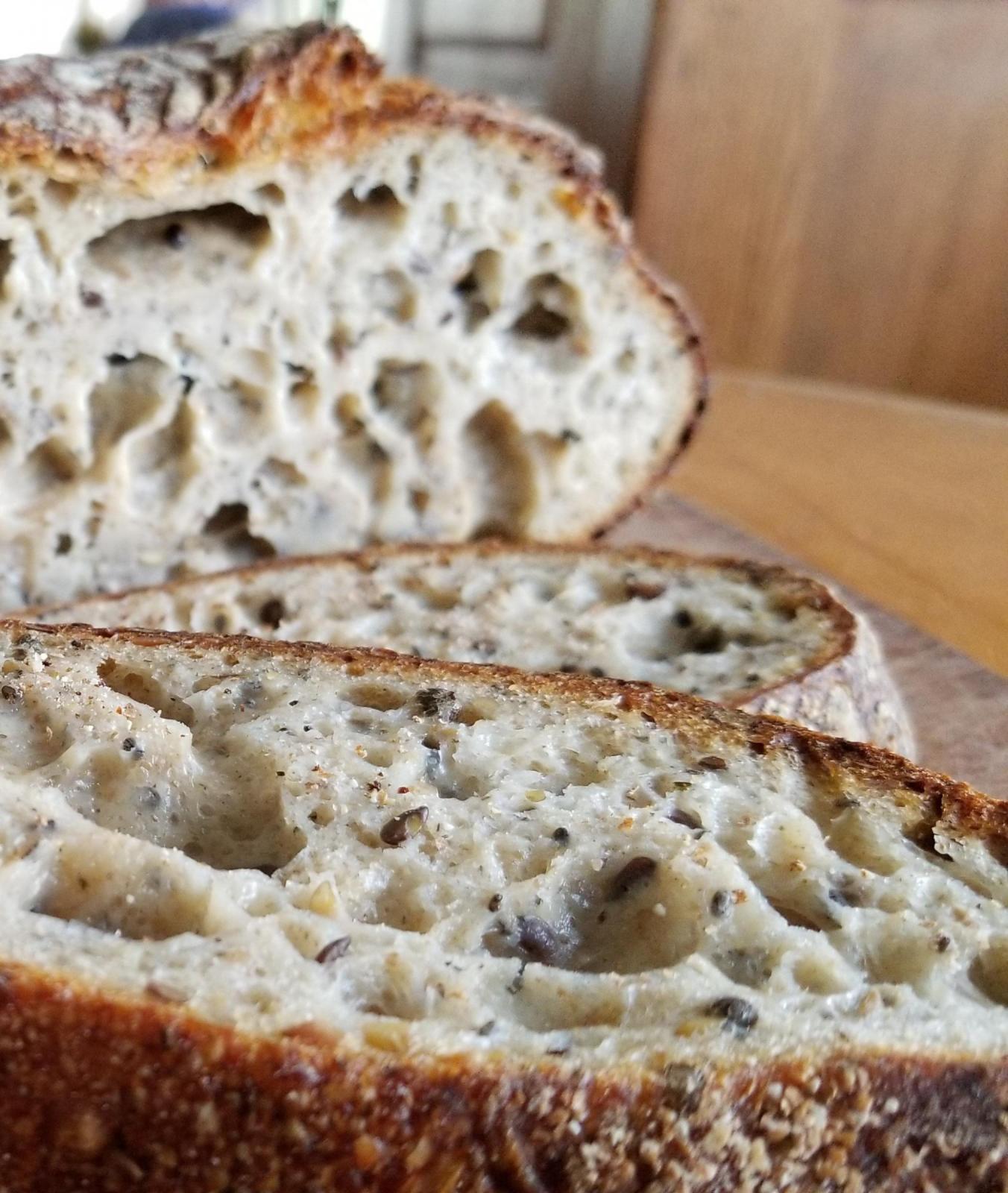I have been exploring the delicious world of porridge breads lately but today I decided to venture away from that...sort of. When I first started baking bread, apart from the therapeutic value of the process, my motivation was primarily nutritional. I wanted to bake bread that tasted good and was good for me...of course how the bread looked, whether the ears were big enough, oven spring, open crumb etc., all those concerns also become apparent on the learning curve but in the end taste and nutrition seem to be what matters most. Being sustained, being able to eat the less-than-perfect-not-what -was-expected results of our baking experiments has been an often stated encouragement from other bakers. We have bread to eat, baked by our own hands...that's a pretty good thing. So my focus for today's bake was first and foremost about nutrition and taste.
I have a palate preconception where bread is concerned - maybe it's because I grew up in Saskatchewan, all that prairie grain creating a taste preference in my DNA - but I like bread that tastes like the grain used to make it, nutty, grassy, mellow, the flavour of a nicely caramelized crust. But I digress...that is my underlying bread bias but not an all or nothing preference. Today I baked a bread that I think tastes pretty good while also having a solid nutritional profile - the aesthetics may have suffered a bit with less oven spring, ears but I am quickly getting rid of the evidence with one loaf going to a neighbour and the other served up for lunch.
As Danni often does, I am using pictures to share what I did for this bake...
I used 250 g mix of fresh milled, sifted (bran kept for final coating) organic rye, hard spring wheat and 750 g all purpose organic flour with 800 g water (this was a little too much water, I think 750 g would have been best) left for 1 hour at room temperature; then 220 g young levain (4 hours) and 20 g sea salt was mixed in to start the bulk fermentation. Four series of stretch and folds every half hour for the first two hours then two hours resting.
After the second series of stretch and folds, 1 hour into the bulk fermentation:
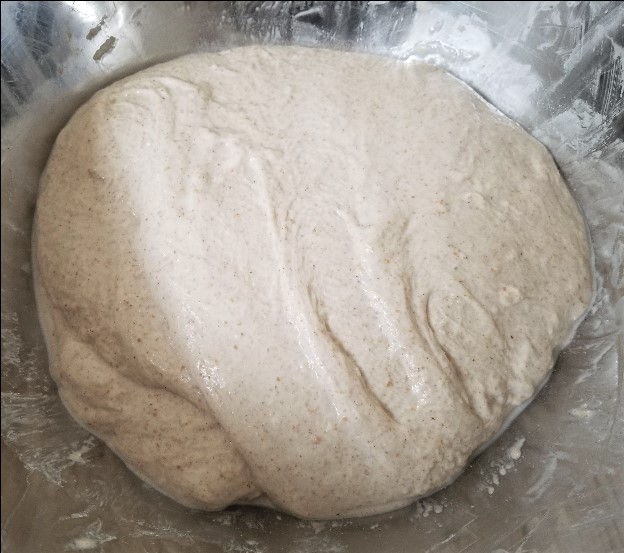
Two additions after the second series of stretch and folds:
The first one - ground up 50 g toasted sesame seeds, 100 g hemp hearts and mixed into a paste with 150 boiling water. The second - 50 g chia, 50 g golden/brown flax, 50 g toasted hemp seeds (not hearts) mixed with 250 g boiling water and left for 2 hours. I recall one of Joze's posts where he was experimenting with hemp flour and sesame; the complimentary flavours worked well in his bread so I thought adding ground hemp hearts and sesame would provide a nutritional component as well as a nice subtle flavour. The toasted hemp seeds were added for their texture and nutritional value as were the flax seeds.

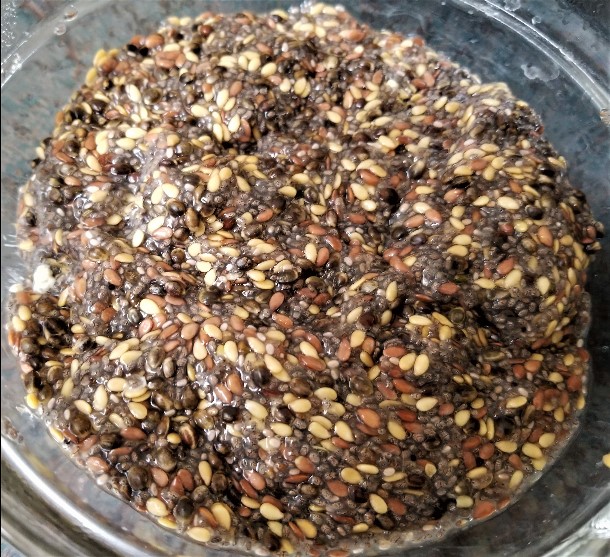

After the final set of stretch and folds, two hours...
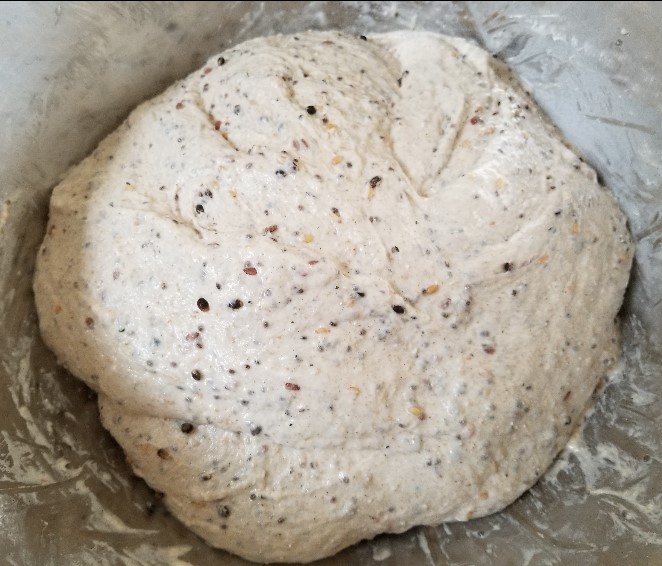
After 4 hours, pre-shaped and left to rest for thirty minutes:
I began with a generous dough hydration characteristic of the Tartine style breads I have been trying to bake but without thought to the affect of the additions on the final dough hydration. Robertson's advice for porridge breads is to cut back his typical 85% hydration to 75% to account for the porridge water. In my mind I was not making a porridge bread so autopilot was engaged and before I had thought it through I had a nice 80% hydration dough to start with...I am not sure the exact final dough hydration but by the feel of the dough at the end of the bulk fermentation (I think the soaker may have released some of it's water into the dough too) it was probably 90%+ It was a bit more challenging handling/shaping the dough.

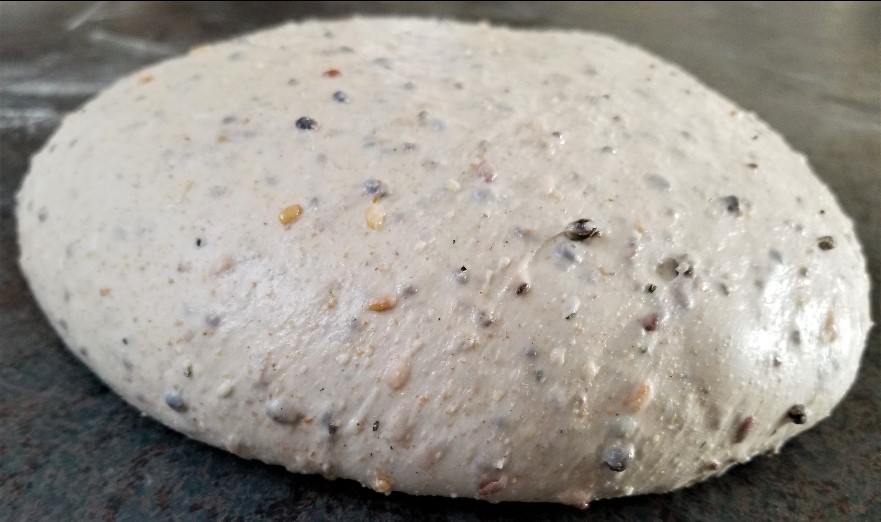
Final shaping and into linen lined proofing baskets:
I was able to gently wrestle and shape the dough into a batard and a boule (you may notice most of my posts have a boule and a batard - it's because I have one Lodge enamelled pot and one oval Creuset). The loaves were dusted with the bran sifted and saved at the start and some rice flour/flour. This bake was also different because the plan came to me early in the day and I decided to forego my preferred overnight cold -proof, doing the whole thing during my day off. Again, always amazing to me how easy it is to slip into autopilot mode - I am so used to final shaping, into baskets and then leaving the loaves overnight in the fridge for 10 hours - I left these loaves to proof in plastic bags at room temperature on the kitchen island and forgot about them! Fortunately I eventually remembered what I was doing before they were too over-proofed - I think they would have been better if baked an hour earlier but it is what it is.

Baked in pots, covered at 500 F for 25 minutes; 450 F for 10 minutes and then uncovered and directly on the oven stone at 450 F for 25 minutes:
The loaves were really floppy coming out of the proofing baskets, very challenging to score and transfer into the pre-heated pots before they spread out too much. I wasn't feeling very optimistic about the final outcome at this point but got them into the pots and into the oven hoping for the best. There wasn't as much oven spring or development of ears as I like (I know, it's just aesthetics!) but the crust and colour looked pretty good coming out of the pots at the halfway point of the bake. They took a little longer to finish, again probably because of the high hydration dough, but they finished up nicely I think.


The crumb shot:
Well, as I started with at the beginning of this post, this bake was supposed to be a change from my of late, usual porridge breads, but in the end, with the high hydration and wet pasty additions it's pretty much that again. I am happy to say, despite being over-proofed, kind of floppy, over hydrated and a bit flat coming out of the oven...this bread tastes really good! The crumb is soft, chewy and gelatinous, the crust is crisp and nutty, the hemp hearts and sesame add a really nice subtle flavour just like Joze said and the toasted hemp seeds add a great, nutty crunch every now and then - a delicious learning experience for the next time I try this.
